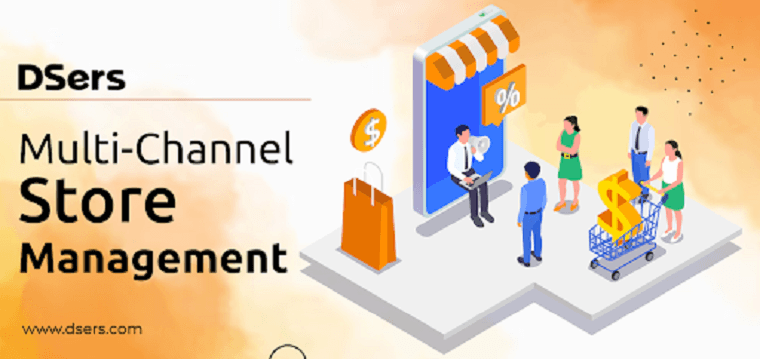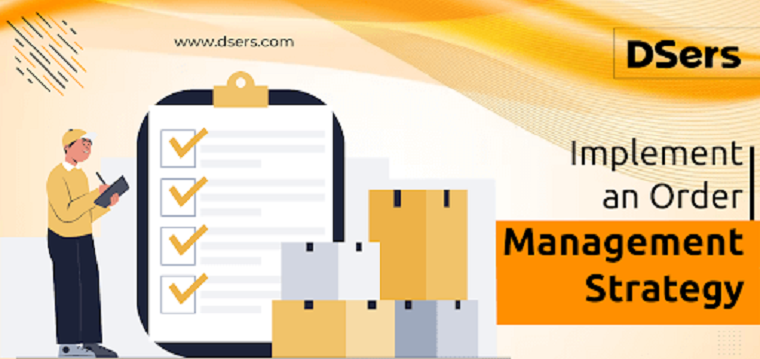How to Master Multi-Channel Store Management for Retail Success

Success in the dynamic retail industry depends on a well-thought-out strategy for order fulfillment, particularly when it comes to multi-channel store management. The exponential development of the global multichannel order management market, which is expected to reach $6.5 billion by 2031 from $2.5 billion in 2021, highlights the growing significance of implementing effective order fulfillment techniques.
This informative blog explores the necessary elements, importance, and doable actions to succeed in the field of multi-channel store management.
What Is Multi-Channel Store Management

Retailers in the present era who want to give their customers a flawless purchasing experience must comprehend multi-channel store management. Essentially, it involves the skill of effectively handling orders on various platforms, including mobile apps, and physical stores. With this strategy, companies can satisfy the wide range of tastes of their clientele and guarantee that they can shop whenever and wherever they choose.
A crucial component of managing many channels well is the capacity to expertly combine these different channels to produce a seamless and uniform client experience. Delivering consistent quality and ease of access across all touchpoints is the significance. This implies that customers may anticipate the same degree of support, availability of products, and general shopping experience whether they shop in-person, online, or through a mobile app.
It's important to understand that multi-channel management entails more than just being present across several platforms. It involves carefully coordinating these channels to successfully satisfy the changing needs and preferences of the consumer base. Through the strategic implementation of customized plans and the optimal utilization of each channel's strengths, companies may simultaneously maximize operational efficiency and foster customer satisfaction and loyalty.
How to Implement Multi-Channel Store Management
Implementing multi-channel store management successfully requires thorough planning, a strong technology foundation, efficient procedures, and, at its core, a customer-centric mindset.
Order Placement
The first crucial step in the customer's purchasing process is placing an order. It includes a wide range of methods that consumers can interact with a retailer's products, including conventional websites, mobile applications, in-person visits to physical storefronts, and even phone orders. Because of the diverse tastes and habits of contemporary customers, each of these channels offers special opportunities as well as obstacles.

|
Place Orders to AliExpress In Seconds DSers Bulk Order - Place 100s of orders to AliExpress in a few seconds with a just few clicks |
In the context of multi-channel store management, it is critical to guarantee a consistent and easy-to-use shopping experience across all of these channels. Orders from these various sources must be effectively integrated and processed, which calls for a strong order management system. A well-implemented order placement strategy also allows retailers to gather insightful data about the behavior and preferences of their customers, which they can use to guide future marketing campaigns and product offerings.
Therefore, the key to managing a multi-channel store effectively is having the capacity to coordinate a seamless and user-friendly order placement procedure that crosses the borders of separate channels and provides customers with an enhanced shopping experience.
Inventory Management
Effective multi-channel store management revolves around inventory management, which necessitates painstaking attention to detail and productivity across all sales channels.
Maintaining precise and efficient inventory management is critical in the dynamic retail industry, as consumer needs are subject to sudden changes and market trends change quickly. This goes beyond simply monitoring product numbers; in order to reduce risks like overselling, stockouts, and delivery delays, real-time synchronization of inventory levels across all channels is needed.
This procedure may be made much more efficient by using centralized inventory management systems, which act as a central location for all inventory data that is updated in real time. Businesses may have thorough visibility into their stock levels and guarantee that the correct products are accessible at the right time, regardless of the sales channel, by combining inventory data from many channels into a single platform.
Order Fulfillment
The core of multi-channel store management is order fulfillment, which includes all order handling, packing, and shipping procedures. This entails several techniques, including dropshipping from suppliers, shipping from a central warehouse, and working with third-party logistics companies.
A carefully thought-out fulfillment strategy guarantees accurate and timely delivery, increasing overall customer satisfaction. A smooth and satisfying purchasing experience is dependent on effective order fulfillment across all channels.
Logistics and Shipping
It takes skill to coordinate with shipping carriers and manage logistics across several channels in order to guarantee a flawless shopping experience. This entails carefully weighing the pros and cons of each item's shipping options, giving timely delivery updates, and guaranteeing reliable tracking information.

|
Pre-set the Best Shipping Methods DSers Shipping Settings - Pre-select your favorite shipping method to save money and time |
In addition to ensuring dependability and on-time delivery, efficient logistics and shipping management also raise customer happiness and cultivate loyalty. Businesses may improve the entire shopping experience and fortify client relationships by placing a high priority on efficiency and dependability in shipping procedures.
Customer Service
Excellent customer service is essential for operating multi-channel stores. It goes beyond simple transactional interactions and includes offering clients regular and reliable service. This entails being available to answer questions as soon as possible, making sure that exchanges and refunds are processed without problems and skillfully handling any problems that may come up during order fulfillment.
Providing outstanding customer service not only encourages favorable word-of-mouth recommendations but also builds client loyalty and trust—two essential elements for long-term business success.
How Multi-Channel Store Management Helps
To achieve a competitive edge in today's ever-changing retail landscape, organizations must successfully execute an order management strategy for their store to create a superior customer experience, generate sales growth, and optimize operations.
Enhance Customer Experience
An order management strategy that is successfully applied across several channels ensures a smooth and uniform client experience. Customers are more likely to stay loyal when they explore, order, and receive things through the channels of their choice. This enhances the chances of customers returning and spreading positive recommendations through word-of-mouth.
In the end, this improved customer experience strengthens the bonds between companies and their customers, which propels long-term growth and success in the competitive retail sector.
Increase Sales Opportunities
Increasing the number of sales channels provides access to new market niches as well as a more diverse consumer. Effective order processing across a variety of channels is ensured by a strong order management strategy, which maximizes revenue potential.
Businesses can take advantage of more sales opportunities and unexplored markets by utilizing a variety of sales channels and streamlining order management procedures. This promotes growth and increases revenue streams.
Improve Inventory Management
A key component of effective multi-channel retail operations is improved inventory management, which helps businesses steer clear of the dangers of overstocking and stockouts.
Centralized inventory management systems provide real-time insight and optimization capabilities through careful planning, allocation, and fulfillment across all sales channels. This eliminates the risk of missed sales opportunities in addition to the expenses related to having extra inventory. In the competitive retail market, companies can increase revenue, improve customer satisfaction, and streamline operations by utilizing these technologies.
Improve Business Performance
Businesses that implement an effective order management strategy can have access to valuable data insights that help them improve operations, hone marketing tactics, and customize product offerings. Businesses can evaluate channel effectiveness, spot sales patterns, and examine client behavior by utilizing data-driven decision-making.
This data-centric approach improves overall business performance by streamlining procedures and identifying growth opportunities. Businesses may stimulate innovation, adjust quickly to changing market conditions, and keep a competitive edge in the ever-changing retail sector by strategically utilizing data.
How to Implement an Order Management Strategy

It takes a combination of customer-focused procedures, technological integration, and strategic planning to execute an order fulfillment strategy effectively. Now, let’s examine these aspects one by one.
Set the Right Goal
Setting up definite objectives and standards is essential to guiding the order management strategy's implementation process. These objectives ought to be measurable so that companies may track their development efficiently.
Objectives such as reducing order processing times or improving inventory accuracy, for example, offer measurable standards for achievement. Businesses may maintain focus and stay on track to achieve their goals by clearly defining goals at each stage of the order management process.
Integrate Systems
Effective order flow across channels and smooth data synchronization are made possible by connecting different systems, including e-commerce platforms, point-of-sale systems, and inventory management software.
Integration makes it possible to combine data from several sources, which lowers the possibility of inconsistencies and mistakes. Businesses may increase operational effectiveness and guarantee a consistent consumer experience across all channels by automating information exchanges across systems.
Streamline Order Processing
Improving order processing entails putting in place efficient processes and workflows to handle consumer orders more quickly. Technology solutions can automate manual operations, like order processing and verification, which saves time and effort when compared to manual intervention.
Businesses may improve customer satisfaction and create a more seamless and error-free experience by optimizing order processing, which also increases efficiency and expedites order fulfillment.
Enable Real Time Inventory Visibility
Effective inventory management requires utilizing technology solutions that provide real-time access to inventory levels. Businesses can rapidly monitor stock levels across all channels with real-time visibility, which makes inventory planning, allocation, and fulfillment more accurate.
Real-time inventory insight improves overall inventory management efficacy and boosts customer satisfaction by reducing stockout risks and guaranteeing timely replenishment.
Provide Consistent Consumer Experience
Building client trust and loyalty requires establishing uniform service standards across all channels. This entails responding to consumer inquiries promptly, putting in place standardized processes for exchanges and refunds, and upholding a consistent approach to customer service across all touchpoints.
Delivering services consistently builds trust and dependability, which improves the client experience overall and raises satisfaction levels.
End Note
A comprehensive strategy focused on technology integration, strategic vision, and customer happiness is needed to implement a successful multi-channel store management strategy. Through the establishment of well-defined goals, comprehension of channel dynamics, inventory consolidation, system integration, and ongoing process optimization, enterprises can surpass client expectations and propel expansion in the dynamic retail environment.
Organizations can confidently handle the difficulties of multi-channel store management by adhering to best practices, monitoring, and adapting continuously. It ensures a smooth and satisfying experience for both customers and businesses.
Want to find out more? Visit DSers blog now.











 Company
Company
 Why Choose DSers
Why Choose DSers
 Blog
Blog
 Help Center
Help Center




 Live Chat
Live Chat